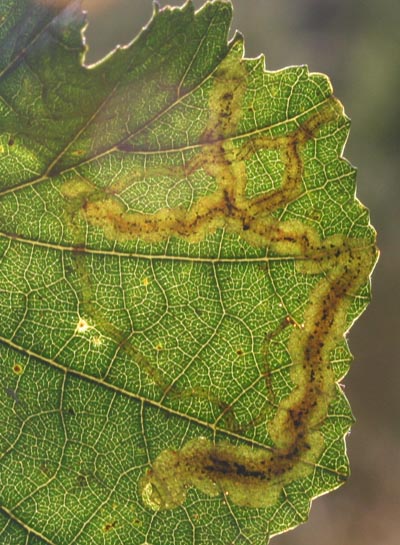Although the primary reason behind my visits to Ards is to explore the fungal flora, I always see a host of other things that attract my attention for one reason or another.
Ards is the only place where I have found the native Golden Rod. It has a distinct requirement for woodland, and the distribution maps tend to show a western bias, and you don't get extensive woodlands much further west in Donegal than Ards.
 |
| Native Golden Rod |
Eagle eyes will have spotted the odd leaf at bottom right: it's a leaf of Honeysuckle that has been mined by
Chromatomyia aprilina:
 |
| Honeysuckle leaf mined by Chromatomyia aprilina |
When trying to track down leaf miners, the frass (dung!) pattern is a very good starting place. Note that the frass (thin black line in the white mine) is distributed in a line down one side of the mine. That's a clear pointer that this mine has been made by the larva of a fly, so we can ignore all the moths, wasps and beetles. That leaves us with just a couple of species of fly that mine Honeysuckle, and we quickly arrive at
Chromatomyia aprilina by the shape of the mine.
Wood Sage is another plant that I only ever find in woodland:
 |
| Wood Sage |
Drumboe in Ballybofey is another place to find it.
Just as I was taking the shots of Wood sage, a shadow passed over and I saw a specimen of Speckled Wood landing on a Rhododendron:
 |
| Speckled Wood butterfly |
Notice that it's in absolutely perfect condition, so that makes it one of the few third-generation specimens for this year. I find fresh specimens in April, July and September, indicating that we have roughly 8 weeks between generations. Interestingly enough, next year's first generation will more than likely be the offspring of this year's summer generation, since a third generation doesn't always happen. It seems that we're seeing a transition from two generations a year to three as warming increases.
I was a little surprised to see
Viola riviniana in flower:
 |
| Viola riviniana - Common Dog Violet |
Sometimes, when conditions are right, our spring flowers can have a second push in autumn. Day length might well be an influence here, since we normally see Dog Violets just after the spring equinox and it's just after the autumn equinox now.
Devilsbit Scabious, on the other hand, is just at its best right now:
 |
| Meliscaeva cinctella on Devilsbit Scabious |
The hoverfly is
Meliscaeva cinctella, which feeds on aphids as a larva.
I rather like that picture.
I found this Oak Cherry gall on a fallen leaf:
 |
| Oak Cherry gall - Cynips quercusfolii |
Galls are plant (or fungal) growths made by insects for their own benefit. The female lays her egg(s) and the plant is thereby stimulated into making unusual material growth on leaves, buds, twigs, seeds or roots. The larva lives inside the growth, feeding on the inside of it. Galls are a pretty good place for an insect to develop: there is protection plus a good supply of food. But wildlife is never that simple. There are other insects who know that the gall contains food, shelter and a larva. These burrow or drill their way into the gall and then one of three things occurs: either the incomer coexists happily with the gall-maker (an inquiline), or it kills the original larva as food either for itself (a predator) or it lays eggs inside the original larva as food for its young (a parasite). It doesn't stop there, however. Some parasites and predators target only the inquilines, and so we can have a changing population of larvae, inquilines, parasites and predators all existing within a single gall. The number of different species taken from inside a single gall specimen exceeds 50.
This spider was hanging vertically on a Hazel leaf. The abdominal pattern indicates the Common Garden Spider -
Araneus diadematus, but the abdomen is much smaller than I usually expect to see. It's suspect it's a male:
 |
| Common Garden Spider - male |
This flower looked a bit strange amongst a bank of normal specimens. I quickly worked out what it was. Can you?
 |
| Mystery flower |
And I almost forgot this huge puffball that I found near the car park. It's
Handkea excipuliformis, around 20 cm tall, with a 7 cm diameter cap:
 |
| Handkea excipuliformis |
The cap will soon develop slits that allow the spores to be forcibly expelled when hit by raindrops or animals (or people with sticks)










































